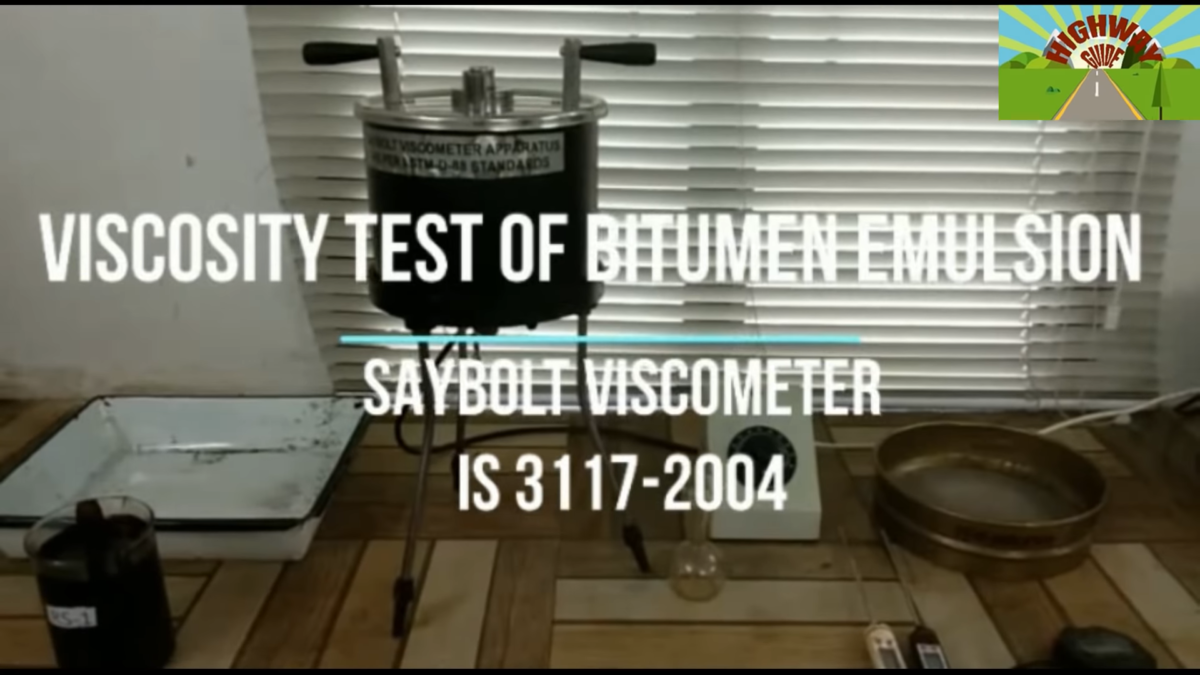Scope:
This test method describes how to find out the viscosity of bitumen emulsion with Saybolt Furol viscometer. It is applicable to all the emulsified asphalts specified in Specifications IS-3117-2004.
Apparatus:
a.Water Bath — Bath equipped with a stirring device and with means for heating or cooling, serves as a support to hold the oil tube in the vertical position and as a container for the bath liquid.
The bath temperature necessary to maintain thermal equilibrium, while the liquid in the oil tube is swell stirred by the oil-tube thermometer, shall vary to within +/- 0.1˚C , for the specified test temperatures given below:
Temperature Range 19 to 27 ˚ C
Temperature of Test 25˚ C
The level of the bath liquid shall be not lower than 0.5 cm above the overflow rim of the oil tube.
b.Oil Tube Thermometers — Four thermometers graduated in degree centigrade which can measures the temperature upto 100˚C or self-reading electronic thermometer.
c.Timing Device — A stop-watch graduated in divisions of 0.2 s or less and accurate to within 0.1 percent when tested over a 60 min period; or other equivalent timing device.
d.Withdrawal Tube or Pipette— Used for draining the gallery, with a smooth tip of about 3 mm outside diameter and about 2 mm inside diameter.
Procedure
1.Make the viscosity determinations in a room free from draughts and rapid changes in temperature.
2.For standardization, the room temperature shall be between 20˚C and 30˚C and the actual temperature shall be recorded & for routine testing , temperatures up to 38°C may prevail without introducing errors in excess of one percent.
3.Clean the oil tube with a solvent, such as benzene, and remove excess solvent from the gallery. Sieve the all sample through a 150 micron IS sieve before pouring into the oil tube. Pour the material in oil tube. Insert the cork stopper , taking care that the cork fits tightly enough to prevent the escape of air, as tested by the absence of oil on the cork after it is withdrawn. If the test temperature is above that of the room, heat the material to not more than 1.5 ˚C above the temperature of test, and if the temperature is below that of the room, cool it to not more than 1.5˚C below the temperature of test.
4.Pour the material into the oil tube until it ceases to overflow into the gallery. Keep it well stirred with the oil tube thermometer, care being taken to avoid touching the outflow tube. Make an adjustment of bath temperature to remain constant of sample temperature. if the indicated bath temperature varies by more than+/- 0.03˚C test result shall be discarded.
5.After the temperature of the material in the oil tube has remained constant with +/- 0.02°C of the desired temperature for 1 min with constant stirring, withdraw the oil tube thermometer and remove the surplus material from the gallery by the help of the withdrawal tube so that the level of the material in the gallery is below the level in the oil tube proper.
6.Place the receiving flask in position in such that flask is not less than 10 cm and not more than 10 cm from the bottom of the bath. Remove the cork from its position and at the same time start the stop watch & Stop the stoop watch when liquid reaches the designated mark of the receiving flask.
Reporting Results
1.Note the time in second as determined from above said procedure & it will be the Saybolt Furol Viscosity of the material at the temperature at which the test is made.
2.Report the results to the nearest 0.1 s for viscosity values below 200 second and to the nearest whole second for values 200 second or above.
Reproducibility Of Results
With proper attention to details of method of procedure, results indifferent laboratories with different operations under referee conditions of testing shall not differ by more than 0.5 percent.For more detail please my video in youtube.

